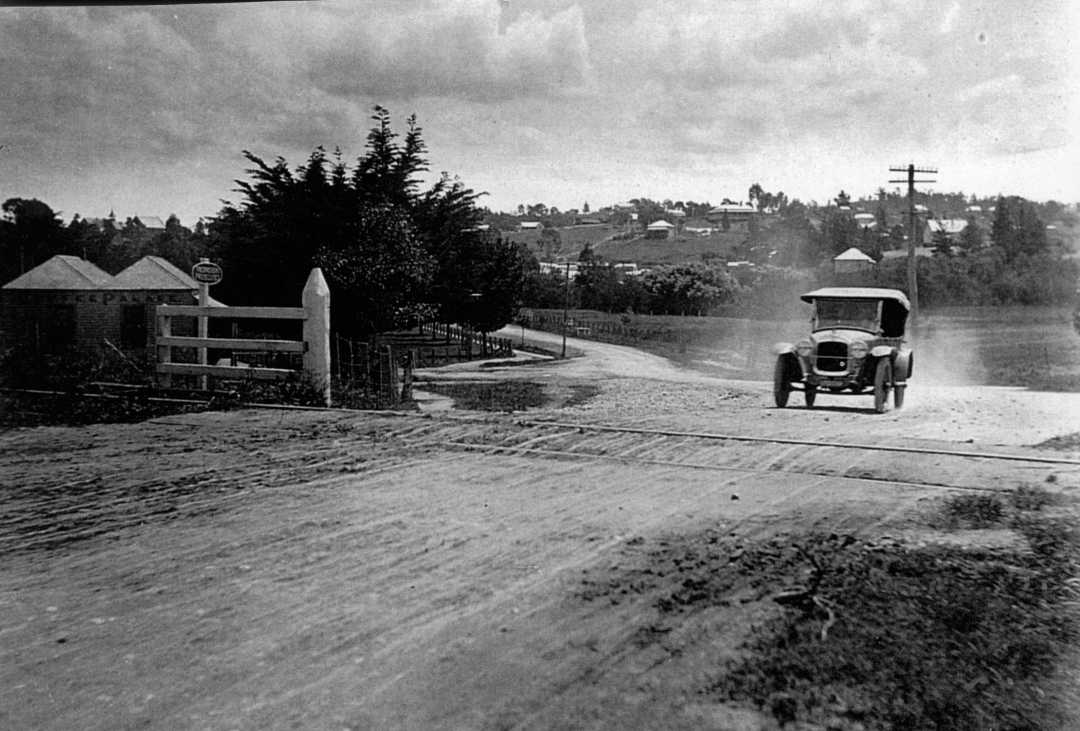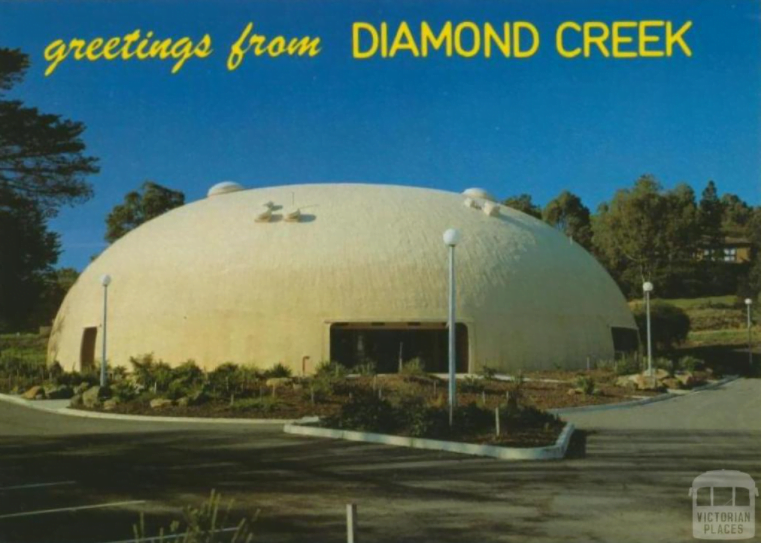This photo in the Nillumbik Historical Society collection of the level crossing at Diamond Creek was taken about 1920. It shows the road behind towards the ovals and bridges and it can clearly be seen that the road alignment is similar to today. The ‘dogleg’ in the road at the crossing has always been there and it relates to the building on the left. At night, or in bad weather, it let coach drivers know they needed to slow down because they were approaching the hotel. The sign on the wooden building has ‘Coffee Palace’ but it was originally the Diamond Reef Hotel built by Dr Phipps to house his miners when he opened the Diamond Creek Gold Mine after gold was discovered in 1862.
From the 1890’s coffee palaces were popular across Melbourne with the influence of temperance and rejection of alcohol in the community. The railway line extension from Eltham to Hurstbridge was opened in 1912 with the tracks laid across the existing road alignment. The coffee palace/hotel was removed in the 1960’s and the Bini Shell was built there as a community centre in the 1979. For more information about the Bini Shell see this Nillumbik Shire Council article on Facebook – the current community centre is now on the site.
For many years there was no signalling to warn drivers of oncoming trains from either direction. This was particularly dangerous because the cutting and bend on the Melbourne side made it difficult to see and hear oncoming trains. Drivers often found it better to stop, look and listen. In 1949, the R.A.C.V. President Sir Thomas Nettlefold raised concerns about the level crossings across the state saying “There was a cutting on the south side of the Diamond Creek crossing which prevented road users approaching from the east seeing a train until they were almost at the railway line. Because of that he thought the expenditure on a ‘wig-wag signal’ was justified.”
An article in the Argus of 21st February 1950, gives an insight into concerns Diamond Creek residents had about the crossing.
“Hoodoo” level crossing worries Diamond Creek
Diamond Creek residents said yesterday that they had been fighting for six years to get a better warning signal at the railway level crossing there. Saturday’s fatal accident was the eighth at this “hoo-doo” crossing. Mr T.W. Harrington, president of the local progress association, said: “There’s not a car or truck driver in the district who hasn’t escaped a train there by ‘the skin of his teeth.’ “ He said that he, Cr. Ryan, and Mr. Stone, JP., had asked the Railways Department for a wig-wag signal in 1947. “The Railways refused because there was adequate warning at the crossing, and because the line was railway property, and motorists were actually “trespassers” Mr. Harrington said. There is a signboard warning sign on both sides of the line, about 100 yards from the crossing. This, if heeded by a motorist travelling at anything up to 35 miles an hour, would give ample time to slow down and pull up. But there is a gradient and a sharp turn in the road right on the crossing. The train coming through the cutting on the Melbourne side can be seen clearly only for the last 70 yards. A motorist’s attention would be distracted from all but a commanding type of warning signal. In theory the crossing is quite safe – in practice a more commanding type of signal is needed. A city magistrate said at an inquest into an accident there last year: “Automatic or wig-wag signals should be installed. The approach to the crossing is awkward, and the present warning signals inadequate.”
Residents were determined to make their railway crossing safer, and wig-wag signals were finally installed, and in following years boom-gates. We now have the signals, lights and gates as they should be but the bend in the line on the Melbourne side is still there.
As the article indicates there were fatal accidents and others where people were injured, however, not all accidents ended in tragedy. One accident had an unexpected humorous side. We are not sure what year it was – An Eltham bound train had just left Diamond Creek when the driver realised that he needed to relieve himself. As he stood at the driver’s door, the train gave a lurch and he fell out. The driverless train continued happily on its way to Eltham where it came to a stop on a slight rise before the Eltham station. The unhurt driver could not catch the moving train so he returned to the Diamond Creek station. Realising the event could raise a lot of difficult questions, it was thought best to call an ambulance so that he could be admitted to hospital. A subsequent enquiry decided that he had become very ill, and no further action was taken!
Don’t forget you can follow us on Facebook too for regular updates and information.



0 Comments